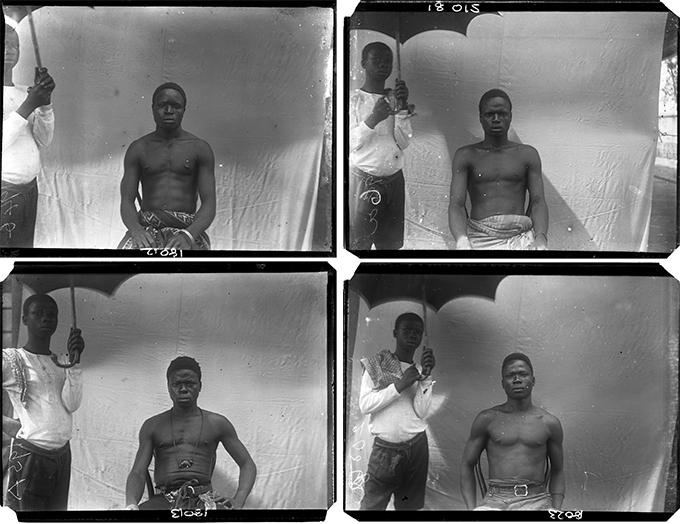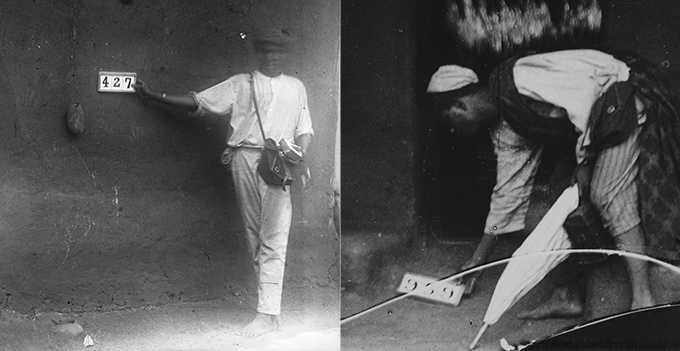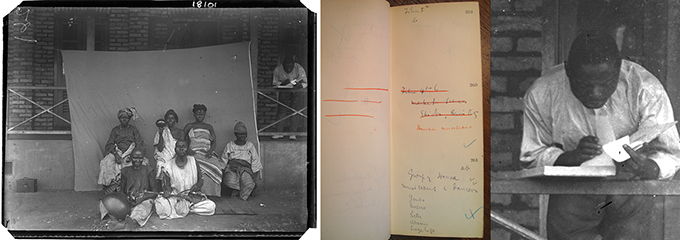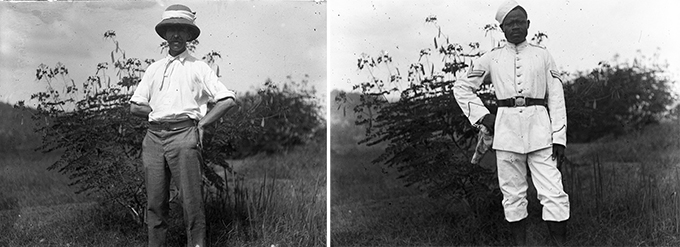
The image of the anthropologist as a heroic, lone fieldworker, battling through adversity in order to single-handedly document disappearing customs and rituals is a tenacious myth. Some anthropologists intentionally portrayed themselves in such terms. Malinowski‘s 1922 monograph, Argonauts of the Western Pacific, famously begins with the lines: ‘Imagine yourself, suddenly set down surrounded by all your gear, alone on a tropical beach close to a native village, while the launch or dinghy which brought you sails away out of sight’. In fact, we know that anthropological fieldwork is – and always has been – a highly collaborative endeavour. The important role of fieldwork collaborators – including fixers, brokers, assistants, interpreters and other participants – has, however, often gone unacknowledged. A notable exception was Franz Boas, who acknowledged his debt to his Tlingit-speaking assistant, George Hunt, who collected much of the data on which Boas’s publications were based.
N. W. Thomas was undoubtedly an energetic fieldworker, travelling extensively in Southern Nigeria and Sierra Leone in the course of some 55-months of anthropological survey work between 1909 and 1915. While Thomas was the sole author of the various reports and publications that resulted from this research, and is credited with assembling the thousands of photographs and sound recordings, and extensive collections of artefacts, botanical specimens and linguistic materials that are the legacy of these surveys, it is clear that this could not be the work of just one man. But who accompanied Thomas on his travels? How many assistants did he have? What roles did they play? One has to look hard to find a trace of such collaborators in the archives of Thomas’s surveys – but they can occasionally be glimpsed as peripheral presences.
This peripheral presence is most literally manifest when Thomas’s assistants appear at the edge of the photographic frame, holding a number board, supporting the photographic background sheet, or diffusing the sunlight with an umbrella. Many of Thomas’s photographic negatives are loosely framed, allowing peripheral detail to creep into the picture. The intention would have been to crop these images prior to publication, removing the traces of their co-production. As an experiment, such photographs can be differently cropped, placing the peripheral presences in the centre of the frame.

Represencing Thomas’s fieldwork collaborators also entails recognising their trace elsewhere in the archive. In negative number NWT 261, a photograph of a group of Hausa musicians and dancers taken in Benin City in 1909, an assistant can be seen on the verandah making notes in what appears to be Thomas’s photographic register. These register books survive in the archives of the Royal Anthropological Institute and, indeed, the handwriting on these pages is not Thomas’s. Has the act of writing this very register entry been captured at the periphery of the frame?

Within the photographic archive of the anthropological surveys, there are just five photographs of N. W. Thomas himself. These were likely taken by Thomas’s field assistants. In one intriguing pair of photographs, taken at the same location, it appears that Thomas and one of his assistants – probably Corporal Nimahan (see below) – have taken it in turns to photograph one another. This raises the question as to how many other photographs in the archive might have been taken by Thomas’s assistants rather than by Thomas himself.

There appears to be only one entry in Thomas’s photographic register books in which it is noted that an assistant has taken a photograph. Thus photograph NWT 283 is described as ‘Burial of Legema, 26.3.09’. Evidently a sequence of four photographs was taken under this same number: 3 and 4 ‘by N.W.T.’, 5 and 6 ‘by John’. In fact we know a little more about ‘John’ compared with Thomas’s other assistants. This was evidently John Osakbo of Benin City. In a surviving letter from Thomas to the Colonial Office, sent from London in May 1910 after the completion of his first anthropological tour, Thomas requests that this assistant be paid a ‘retaining fee’ of £1 a month until his return to West Africa. Thomas describes John Osakbo as ‘the most capable boy I ever saw’, but notes that he was illiterate, and that the retaining fee should be paid on condition that he learn to read and write, and that he should also ‘receive training in photography’. It appears that Thomas’s request was granted. Thomas also recorded a phonograph of John Osakbo playing a song on a high-pitched woodwind instrument. Thomas’ voice can be heard at the start of the wax cylinder recording (NWT 16; BL C51/2164), ‘…song played by my servant, John, February 10th, 1909’.
It is likely that the number of individuals who accompanied N. W. Thomas on his travels varied from tour to tour. He travelled with camp equipment as well as photographic kit, phonograph and much else and would therefore have needed carriers. He seems to have travelled on foot, on bicycle and by hammock. In a letter to the Royal Botanic Gardens, Kew, written in 1928, recalling the collecting of vernacular names of plant species in Sierra Leone, Thomas mentions that Temne and Mende plant names were obtained from his hammock boys, and that they had been recruited in Freetown. Thomas relied on the assistance of interpreters, not only in his day-to-day interactions with people in the communities he visited, but also in compiling vocabularies and other linguistic data. In the preface to Part II of Anthropological Report on the Edo-speaking Peoples of Nigeria, concerned with linguistics, Thomas provides a list of the interpreters with whom he worked during his first tour and explaining the methodology he employed. Their names are: Erumese (Edo/Benin City), Nimahan (Kukuruku and Ishan), Osidora (Agbede and Kukuruku), Ogbedo (Edo/Benin City), James Smart (Sobo), George, Oganna and Isuma (Kukuruku). Nimahan was a corporal of the Southern Nigeria Police, and appears to have acted as both official interpreter and as representative of colonial authority. In Part III of Anthropological Report on Sierra Leone: Timne Grammar and Stories, Thomas notes that the first twelve stories published in the book ‘were recorded from the mouth of various members of my staff’.
In conclusion, by attending to their peripheral presences in the archive, it is clear that N. W. Thomas was not a lone fieldwork, but was accompanied and assisted in his anthropological survey work by an entourage of collaborators. While further work needs to be done to identify both the names and full range of activities they undertook, it is evident that their roles were fluid (‘hammock boys’, for example, provided ethnographic and linguistic information and did not simply transport the anthropologist on his itinerations). These collaborators were not peripheral to the anthropological project, but were in fact central to the endeavour. Hopefully, through the [Re:]Entanglements project, we will be able to identify more of N. W. Thomas’s Nigerian and Sierra Leonean collaborators, and correct the erroneous impression that Thomas was single-handedly responsible for assembling this remarkable ethnographic archive.